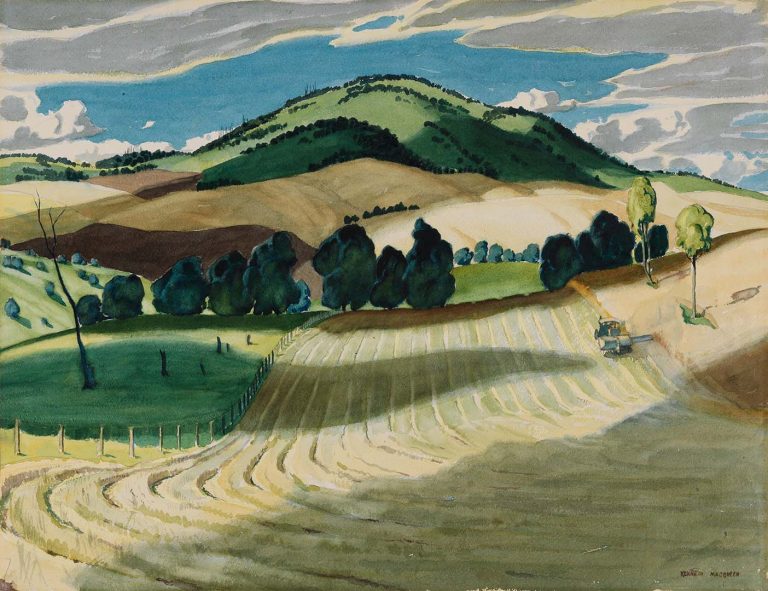We acknowledge the Traditional Owners of the land on which the Queensland Art Gallery | Gallery of Modern Art stands and recognise the creative contribution First Australians make to the art and culture of this country.

Kenneth Macqueen / Australia 1897–1960 / Harvesting scene c.1956 / Watercolour over pencil on wove paper / 38.3 x 49.9cm / Purchased 1956 / Collection: Queensland Art Gallery | Gallery of Modern Art / © Estate of Kenneth Macqueen
Kenneth MacqueenHarvesting scene c.1956
Not Currently on Display
The patterns of nature, and those Kenneth Macqueen imposed on it, were a never-ending source of inspiration for the artist. As he described:
‘Perhaps your quarry may be a newly noted clump of trees, passed a hundred times before without the beauty of their shapes realised, or a freshly green crop laid like a counterpane on a straw-coloured hillside.’
In Harvesting scene 1956, the contrast between the areas of light and shadow cast by clouds across the paddocks provides additional visual interest. The furrows created by the tractor lead the viewer’s eye into the landscape and upward over rolling paddocks to a hill set high against a cloudy sky.
The method of contour ploughing depicted in this painting was introduced from America, and was employed by the Macqueen brothers, Kenneth and Jack, from the mid 1940s in an effort to reduce soil erosion on their property on the Darling Downs. Macqueen captured the striking visual effects produced by the technique in a number of his other watercolours.
Born in Ballarat, Victoria, in 1897, Kenneth Macqueen began to take a serious interest in watercolour painting as a 10-year-old, after watching a young friend use the medium. In 1909, Macqueen’s family moved to Sydney, where he received professional tuition in drawing from a commercial artist, Mr Beecroft.
In 1916, Macqueen enlisted with the Australian Imperial Force and was sent to France where he served with the 12th Army Brigade, Australian Field Artillery. He continued to paint, producing small watercolours in the field, and he pursued his art studies through a London-based correspondence course.
Macqueen returned to Australia in 1919 and, in 1922, he and his brother Jack settled on a property at Mount Emlyn, near Millmerran on Queensland’s Darling Downs. This area and the nearby coast provided his main subject matter from this time. He maintained a national profile, exhibiting regularly in Sydney and in other state capitals. His version of Modernism brought a fresh approach to the genre of landscape painting. His work was included in the exhibition ‘Art of Australia: 1788–1941’, which travelled to the United States and Canada in 1941. His watercolour Cabbage gums and cypress pines c.1940 was subsequently acquired by the Metropolitan Museum of Art, New York.